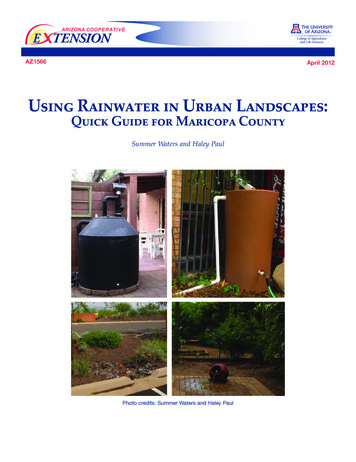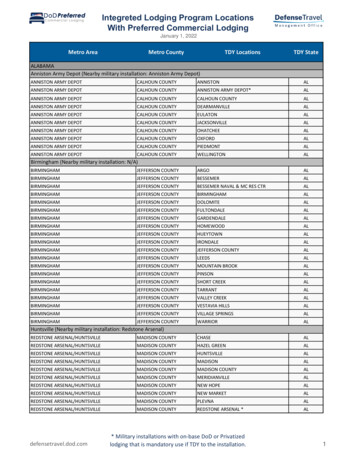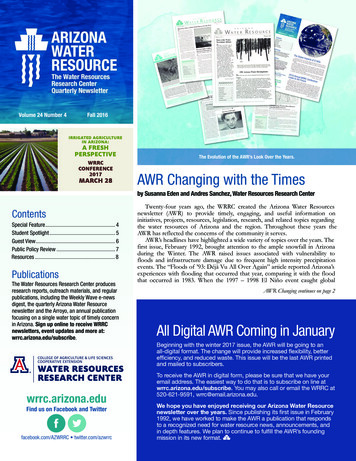
Transcription
ARIZONA COOP E R AT I V EE TENSIONAZ1566April 2012Using Rainwater in Urban Landscapes:Quick Guide for Maricopa CountySummer Waters and Haley PaulPhoto credits: Summer Waters and Haley Paul
Rainwater harvesting is an ancient technique that has beenpracticed for thousands of years in desert regions. Wateris a precious resource in the Valley of the Sun where thesemiarid climate that characterizes most of Arizona bringsplenty of clear, dry, sunny days. Harvesting rainwaterinvolves capturing and directing precipitation, typically foruse outdoors on landscaped areas. Understanding how toimplement rainwater harvesting at your own home presentsopportunities for using water more efficiently.What is rainwater harvesting and why do it?Rainwater harvesting can offset the use of potable wateroutdoors. In the Phoenix metropolitan area up to 70% of ahousehold’s water consumption may be devoted to outdooruses such as in pools and landscapes. Potable water istreated to drinking water standards, which is a costly andenergy intensive process. By using rainwater instead ofpotable water on your landscape, you conserve energy andwater. Plus you can save money!Low mineral content is another advantage of rainwater.Because other Valley water supplies are generally higherin salts, and many plants cannot tolerate high saltconcentrations, rainwater is a welcome alternative forlandscape plants and soils.Finally, by keeping rainwater on your property for use inlandscape irrigation, less becomes urban runoff. Rainwaterthat flows across rooftops, roadways, sidewalks, urbanlandscapes, and driveways often comes in contact withcontaminants such as fertilizers, pesticides, and motor oil.The runoff then flows to a nearby water body, carryingpollution with it. By reducing the runoff from yourproperty, you also reduce the potential for water pollution.But it never rains!Many people think that it doesn’t rain enough in thedesert to collect a worthwhile amount of water. Butconsider this: In a one inch rainstorm, you can collect 600gallons of rainwater off a 1,000 square foot roof. MaricopaCounty receives an average of 7-8 inches of rain a year. Thatamounts to a lot of free water for your landscape!Arizona has a bimodal rainfall pattern. This means thatmost of the rainfall we receive occurs in the winter months(December-February) and during the monsoon season (JulySeptember). Because most rain falls during these two timeperiods, when it rains, it can really pour!2The University of Arizona Cooperative ExtensionHow do you harvest rainwater?There are two main approaches to rainwater harvesting:active and passive.Active rainwater harvestingTo many people, active harvesting is the most recognizablemethod of rainwater collection because it uses a cistern,tank, or barrel to collect and store rainwater for later use.With active harvesting, rainwater washes off a structureand is funneled to a holding container. For example, a roofwith gutters directs rainwater to a downspout where it iscollected in a container.Having a screen at the opening of the container isimportant to keep out animals, such as mice or mosquitoes,as well as debris. If the collection surface is particularly dirty(e.g.: if there are a lot of bird droppings or asphalt roofing),or you want a high quality of water, a first flush device isimportant to consider.Keep in mind that active systems can be underground aswell. For those who do not want the appearance of a cistern,underground storage tanks can be utilized. However,because water is underground, a pump will be needed tobring water to the surface where it can be used in supplyingwater to an irrigation system or a water feature. See Figure4 for an example of a “hidden” underground cistern.Passive rainwater harvestingPassive harvesting involves shaping the landscape intofeatures such as berms, basins, contours, and swales todirect, hold, and percolate water slowly into the ground.Passive harvesting features are designed to slow the flowof water so that it can soak into the soil, providing anopportunity to irrigate landscape plants more thoroughlywith rainwater. Desert adapted plants do best withinfrequent, deep watering. By carefully contouring yourlandscape, you take full advantage of rainfall events bykeeping more rainwater on site instead of immediatelywhisking water off of your property and into the street. Asa rule of thumb, passively harvested rainwater should notremain pooled or standing for more than 72 hours due tothe potential for mosquitos.Keep an eye out for the “also known as” practices thatincorporate passive rainwater harvesting techniques.These include: low-impact development (LID), greeninfrastructure, permaculture, and stormwater management.
Figure 3.The overflow pipe—made with PVC (or ABS) material found at yourlocal hardware store—takes water away from the cistern and the foundation ofthe building in the event that the cistern fills to capacity.Figure 1. A cistern is placed under a gutter, where it collects rainwater from theroof. The screen and first flush device capture debris and pollutants.Figure 2. Curb cuts in a parking lot passively harvest rainwater by diverting itinto a swale where native vegetation can take advantage of the supplementalwater.Figure 4. A permeable paver patio at the UA Cooperative Extension office inMaricopa County sits atop a storage container capable of holding 750 gallonsof rainwater, which is used to supply the water feature.The University of Arizona Cooperative Extension3
Planning aheadPlanning and preparing for all of the rainfall you arecapable of collecting and utilizing is critical to implementinga successful rainwater harvesting project, whether youchoose to use active or passive rainwater harvestingtechniques. You may even decide to use a combination ofboth. Calculating the potential rainwater supply for yourarea as well as your landscape’s water demand will helpyou determine how many barrels, cisterns, or tanks youneed, and how big those containers should be. It will alsohelp you design for overflow and determine plant palette.Remember that in Maricopa County, annual rainfallaverages 7-8 inches. To calculate your annual rainwatercollection potential, first measure your collection area (forexample, a 50-foot-long by 20-foot-wide roof is 1,000 squarefeet). Then multiply your collection area by your annualrainfall, along with 0.6 (this number converts inches togallons). Collection areas can be parking lots, roofs, yards,or any other area from which you are collecting rainwaterand diverting it for use into your landscape.So, for example:1,000 ft2 roof 7 (inches of annual rainfall) 0.6 (conversion factor) 4,200 gallons a year rainwater collection potentialHow much water does my landscapeneed?There is no one-size-fits-all answer to this question. Waterdemand can vary greatly depending on the plants you choosefor your landscape. If you use native and desert adaptedplants, your landscape will need less water than if you have alarge area of turf grass or non-desert adapted plants, like Ficustrees. For a useful guide on watering your landscape, referto Landscape Watering by the Numbers, which was developedby Water—Use it Wisely. There is a tool available online tohelp you determine how much water your irrigation systemcurrently applies, and how much water your landscapeplants need. Be sure to turn your irrigation controller offafter it rains in order to take full advantage of precipitationon your landscape. While you’re at it, familiarize yourselfwith the irrigation controller. You should be adjusting yourcontroller with the seasons to take climate into account. Forexample, landscapes need less water in the winter than inthe summer. If you are unsure about how to adjust yourcontroller or determine your landscape water needs, consulta trained landscape professional for an irrigation tune-up.All of these publications and resources are available underthe “Additional Resources” section located at the end of thisdocument.Getting started: Groups that are hereto helpFor a more extended calculation that includes a runoffcoefficient specific to different collection surfaces, pleasevisit the University of Arizona Cooperative Extension’sHarvesting Rainwater for Landscape Use (page 20). Moreinformation on this publication can be found in the“Additional Resources” section.There are organizations in Maricopa County that holdworkshops, tours, events, trainings, and hands-on projectsto help you learn more about passive and active rainwaterharvesting systems. The contact information for these groupsis listed in Table 1.Calculating your collection potential also helps youplan for overflow in the event that a storm exceeds yoursystem’s collection capacities. Overflow, mentioned above,is critical in the rainwater harvesting planning process. Nomatter how well you plan, a time will likely come when astorm brings more rainfall than your system can hold. Beprepared for a high intensity rainfall event! For an activesystem, this means installing a pipe that takes excess wateraway from the cistern and away from the foundation of ahouse. For a passive system, consider how the propertywas originally designed to manage stormwater. Keep inmind that flooding can damage your home, which is whyplanning for overflow is so important. The key to successfulrainwater harvesting is collecting only what you need andallowing the rest to follow the appropriate path away fromyour property when necessary.Rainwater harvesting demonstration sites in MaricopaCounty abound. These demonstration sites can help you get abetter idea of what you could do on your property or in yourcommunity. The contact information for these sites is listedin Table 2. This information is meant as guidance; the sitesand organizations listed are not maintained or endorsed bythe University of Arizona unless otherwise noted.4The University of Arizona Cooperative ExtensionWhere can I go for examples?Where can I get materials?Local hardware and home improvement stores offer manyof the items you will need to begin harvesting rainwater.A tip: look online as well as in the store for these specialtysupplies.Additionally, there are local landscaping and rainwaterharvesting companies that offer services to build your dreamrainwater harvesting system.
Table 1. Organizations in Maricopa CountyOrganizationContact InformationUniversity of Arizona Cooperative Extension, Maricopa 602) 827-8200Municipal Water Conservation Officeshttp://amwua.org(602) 248-8482Watershed Management Grouphttp:// watershedmg.org/(520) 396-3266Valley Permaculture Alliancehttp://phoenixpermaculture.org/(602) 325-1230The University of Arizona Cooperative Extension5
Table 2. Demonstration sites in Maricopa CountySite/ OrganizationLocation/ Contact InformationOutdoor Water Conservation Demonstration Area at the University of ArizonaCooperative Extension, Maricopa County4341 E. Broadway RDPhoenix, AZ 85040(602) 827-8200OPEN TO THE PUBLICGlendale Xeriscape Garden at the public library, Tree Trail with passiveharvesting features5959 W. Brown STGlendale, AZ 85302(623) 930-3535OPEN TO THE PUBLICCity of Scottsdale Xeriscape Demonstration Garden with various rainwaterharvesting features5401 N Hayden RdScottsdale, AZ 85250(480) tion/Garden/GarTopics/RainHarvestingOPEN TO THE PUBLICMusical Instrument Museum with passive harvesting examples in the parkingarea4725 E. Mayo BoulevardPhoenix, AZ 85050(480) 478-6000FEATURES ON DISPLAY OUTSIDE MUSEUMRegents apartment complex with passive harvesting from the parking lot15555 N. Frank Lloyd Wright Blvd.Scottsdale, AZ 85260(480) 614-6500VISITORS MAY WANT TO CHECK IN AT LEASING OFFICERyan and Ericka Wood residence480-874-2272ryan@cerowood.comPLEASE CALL AHEADValley Permaculture Alliance’s Sustainable Home ToursLocations and features varyhttp://www.phoenixpermaculture.org/SUBJECT TO TOUR SCHEDULEGlendale Community College North Campus rainwater retention basin5727 West Happy Valley RoadGlendale, AZ 85310(623) 845-4000VISITORS MAY WANT TO CALL AHEADCity of Scottsdale’s Interpretive Center at the McDowell Sonoran Preservefeatures a 20,000 gallon underground cistern and artistic gutters18333 N. Thompson Peak Pkwy.Scottsdale, AZ 85255(480) 312-7722OPEN TO THE PUBLICCity of Scottsdale’s Fire Station 2 utilizes permeable pavers7522 E. Indian School RoadScottsdale, AZ 85251(480) 312-FIRE (3473)VISITORS MAY WANT TO CALL AHEADTempe Women’s Club Park demonstrates passive harvesting with berms andswales1265 N College AveTempe, AZ features.htmOPEN TO THE PUBLIC6The University of Arizona Cooperative Extension
Additional ResourcesUniversity of ArizonaOther organizations¡ RainScapes: The Ultimate in Water-Efficient Landscaping¡ Green Infrastructure for Southwestern Neighborhoods Watershed Management fhttp://watershedmg.org/node/179¡ Harvesting Rainwater for Landscape Use¡ The Online Rainwater Harvesting .pdfhttp://www.harvesth2o.com/index.shtml¡ When it Rains it Runs Off: Runoff and Urbanized Areas inArizona¡ American Rainwater Catchment Systems 42.pdf¡ Layperson’s Guide to Arizona Waterhttp://ag.arizona.edu/AZWATER/WRRC EventsNews/LPG/Layperson%27s Guide to Arizona Water.pdf¡ Listing of Smartscape Certified landscape professionalshttp://www.amwua.org/ss directory.html¡ Educational photo album of the installation of arainwater harvesting system at the University of ArizonaCooperative Extension in Maricopa Countyhttp://www.arcsa.org/index.asp¡ Brad Lancaster Rainwater harvesting author and experthttp://www.harvestingrainwater.com/Need additional help?¡ Contact the Water Resources Extension Agent forMaricopa County- (602) 827-8200- swaters@cals.arizona.edu- on.fb.me/HmZQcX¡ Live weather data streaming from the University ofArizona Cooperative Extension, Maricopa Countyweather ¡ Rainlog.org is a cooperative rainfall monitoringnetwork for Arizona maintained by citizen scientist datacontributors.http://Rainlog.orgState of Arizona¡ Water conservation systems tax credit ArizonaDepartment of vationSystems.aspxCities within Maricopa County¡ Landscape Plants for the Arizona Desert ArizonaMunicipal Water Users Associationhttp://www.amwua.org/landscape plants.html¡ Water conservation rebates Select citieshttp://amwua.org/rebates.html¡ Landscape Watering by the Numbers Water-Use itWiselyhttp://amwua.org/landscape watering brochure.html¡ Monthly irrigation e-mail reminder City of Mesahttp://mesaaz.gov/Home/EmailLists.aspxselect “Landscape Watering Reminder”The University of Arizona Cooperative Extension7
ARIZONA COOP E R AT I V EE TENSIONTHE UNIVERSITY OF ARIZONACOLLEGE OF AGRICULTURE AND LIFE SCIENCESThe University of ArizonaCollege of Agriculture and Life SciencesTucson, Arizona 85721Summer WatersExtension Agent, Water resourcesHaley PaulProgram Coordinator, Senior, ANR/SmartscapeContact:Summer WatersSWaters@cals.arizona.eduThis information has been reviewed by University r titles from Arizona Cooperative Extension can be found at:cals.arizona.edu/pubsAny products, services or organizations that are mentioned, shown or indirectly implied in this publicationdo not imply endorsement by The University of Arizona.Issued in furtherance of Cooperative Extension work, acts of May 8 and June 30, 1914, in cooperation with the U.S. Department of Agriculture,Jeffrey C. Silvertooth, Associate Dean & Director, Economic Development & Extension, College of Agriculture and Life Sciences, The University ofArizona.The University of Arizona is an equal opportunity, affirmative action institution. The University does not discriminate on the basis of race, color,religion, sex, national origin, age, disability, veteran status, or sexual orientation in its programs and activities.
water to an irrigation system or a water feature. See Figure 4 for an example of a "hidden" underground cistern. Passive rainwater harvesting Passive harvesting involves shaping the landscape into features such as berms, basins, contours, and swales to direct, hold, and percolate water slowly into the ground.











